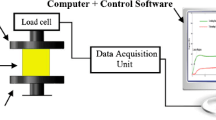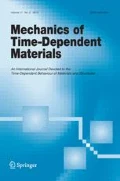Abstract
This article deals with the visco-hyperelastic modelling approach for compressible polymer foam materials. Polymer foams can exhibit large elastic strains and displacements in case of volumetric compression. In addition, they often show significant rate-dependent properties. This material behaviour can be accurately modelled using the visco-hyperelastic approach, in which the large strain viscoelastic description is combined with the rate-independent hyperelastic material model. In case of polymer foams, the most widely used compressible hyperelastic material model, the so-called Ogden–Hill’s model, was applied, which is implemented in the commercial finite element (FE) software Abaqus. The visco-hyperelastic model is defined in hereditary integral form, therefore, obtaining a closed-form solution for the stress is not a trivial task. However, the parameter-fitting procedure could be much faster and accurate if closed-form solution exists. In this contribution, exact stress solutions are derived in case of uniaxial, biaxial and volumetric compression loading cases using ramp-loading history. The analytical stress solutions are compared with the stress results in Abaqus using FE analysis. In order to highlight the benefits of the analytical closed-form solution during the parameter-fitting process experimental work has been carried out on a particular open-cell memory foam material. The results of the material identification process shows significant accuracy improvement in the fitting procedure by applying the derived analytical solutions compared to the so-called separated approach applied in the engineering practice.
















Similar content being viewed by others

References
Aili, A., Vandamme, M., Torrenti, J.M., Masson, B.: Theoretical and practical differences between creep and relaxation Poisson’s ratios in linear viscoelasticity. Mech. Time-Depend. Mater. 19, 537–555 (2015)
Anani, Y., Alizadeh, Y.: Visco-hyperelastic constitutive law for modeling of foam’s behavior. Mater. Des. 32, 2940–2948 (2011)
ANSYS Inc.: Mechanical, version 13.5 (2016). www.ansys.com
Ashby, M., Shercliff, H., Cebon, D.: Materials: Engineering, Science, Processing and Design. Butterworth–Heinemann, Stoneham–Portsmouth (2007)
Bekkour, K., Scrivener, O.: Time-dependent and flow properties of foams. Mech. Time-Depend. Mater. 2, 171–193 (1998)
Berezvai, S., Kossa, A.: Effect of the skin layer on the overall behavior of closed-cell polyethylene foam sheets. J. Cell. Plast. 52(2), 215–229 (2016)
Bower, A.F.: Applied Mechanics of Solids. CRC Press, Boca Raton (2010)
Briody, C., Duignan, B., Jerrams, S., Tiernan, J.: The implementation of a visco-hyperelastic numerical material model for simulating the behaviour of polymer foam materials. Comput. Mater. Sci. 64, 47–51 (2012)
Dassault Systèmes: Abaqus, version 6.14-2 (2016). www.3ds.com/products-services/simulia/products/abaqus/
de Souza Neto, E., Peric, D., Owen, D.: Computational Methods for Plasticity: Theory and Application. Wiley, New York (2008)
Doghri, I.: Mechanics of Deformable Solids. Springer, Berlin (2000)
Elfarhani, M., Jarraya, A., Abid, S., Haddar, M.: Fractional derivative and hereditary combined model for memory effects on flexible polyurethane foam. Mech. Time-Depend. Mater. 1–21 (2016), online first. doi:10.1007/s11043-016-9291-2
Gibson, L.J., Ashby, M.F.: Cellular Solids: Structure and Properties. Cambridge University Press, Cambridge (1997)
Goh, S., Charalambides, M., Williams, J.G.: Determination of the constitutive constants of non-linear viscoelastic materials. Mech. Time-Depend. Mater. 8, 255–268 (2004)
Hill, R.: Aspects of invariance in solid mechanics. Adv. Appl. Mech. 18, 1–78 (1978)
Khajehsaeid, H., Arghavani, J., Naghdabadi, R., Sohrabpour, S.: A visco-hyperelastic constitutive model for rubber-like materials: a rate-dependent relaxation time scheme. Int. J. Eng. Sci. 79, 44–58 (2014)
Knauss, W., Emri, I., Lu, H.: Handbook of Experimental Solid Mechanics: Mechanics of Polymers—Viscoelasticity. Springer, Berlin (2008)
Kossa, A., Berezvai, S.: Visco-hyperelastic characterization of polymeric foam materials. In: 32nd International Danubia–Adria Symposium on Advances in Experimental Mechanics, Slovakia (2015)
Kossa, A., Berezvai, S.: Novel strategy for the hyperelastic parameter fitting procedure of polymer foam materials. Polym. Test. 53, 149–155 (2016a)
Kossa, A., Berezvai, S.: Visco-hyperelastic characterization of polymeric foam materials. Mater. Today, Proc. 3, 1003–1008 (2016b)
Lee, S., Knauss, W.: A note on the determination of relaxation and creep data from ramp tests. Mech. Time-Depend. Mater. 4, 1–7 (2000)
Marques, S.P.C., Creus, G.J.: Computational Viscoelasticity. Springer, Berlin (2012)
Mills, N.: Polymer Foam Handbook: Engineering and Biomechanics Applications and Design Guide. Butterworth–Heinemann, Stoneham–Portsmouth (2006)
MSC Softwares: Marc (2016). www.mscsoftware.com/product/marc
Ogden, R.W.: Large deformation isotropic elasticity: on the correlation of theory and experiment for compressible rubberlike solids. Proc. R. Soc. Lond. Ser. A, Math. Phys. Sci. 328, 567–583 (1972)
Pawlikowski, M.: Non-linear approach in visco-hyperelastic constitutive modelling of polyurethane nanocomposite. Mech. Time-Depend. Mater. 18, 1–20 (2014)
Sakai, T., Tao, T., Somiya, S.: Estimation of creep and recovery behavior of a shape memory polymer. Mech. Time-Depend. Mater. 19, 569–579 (2015)
Schrodt, M., Benderoth, G., Kuhhorn, A., Silber, G.: Hyperelastic description of polymer soft foams at finite deformations. Tech. Mech. 25, 162–173 (2005)
Silber, G., Then, C.: Preventive Biomechanics. Springer, Berlin (2013)
Sorvari, J., Malinen, M.: Determination of the relaxation modulus of a linearly viscoelastic material. Mech. Tim 10, 125–133 (2006)
Spanier, J., Oldham, K.: An Atlas of Functions. Springer, Berlin (1987)
Storåkers, B.: On material representation and constitutive branching in finite compressible elasticity. J. Mech. Phys. Solids 34, 125–145 (1986)
Weber, H., Wolf, T., Unger, U.: Determination of relaxation moduli and Poisson’s ratio in uniaxially loaded solid polyethylene foam specimens as part of full material characterization. Mech. Time-Depend. Mater. 1, 195–208 (1997)
Wolfram: Mathword: incomplete gamma function (2016a). mathworld.wolfram.com/IncompleteGammaFunction.html
Wolfram Research: Mathematica, version 10.3 (2016b). www.wolfram.com/mathematica
Yang, L., Shim, V.: A visco-hyperelastic constitutive description of elastomeric foam. Int. J. Impact Eng. 30, 1099–1110 (2004)
Acknowledgements
This research has been supported by the Hungarian Scientific Research Fund, Hungary (Project Identifier: PD 108691) and the National Talent Programme of the Hungarian Government (Contract Identifier: NTP-EFO-P-15-0085). The research leading to these results has received funding from the Hungarian–American Enterprise Scholarship Fund’s (HAESF). These supports are gratefully acknowledged.
Author information
Authors and Affiliations
Corresponding author
Rights and permissions
About this article
Cite this article
Berezvai, S., Kossa, A. Closed-form solution of the Ogden–Hill’s compressible hyperelastic model for ramp loading. Mech Time-Depend Mater 21, 263–286 (2017). https://doi.org/10.1007/s11043-016-9329-5
Received:
Accepted:
Published:
Issue Date:
DOI: https://doi.org/10.1007/s11043-016-9329-5



